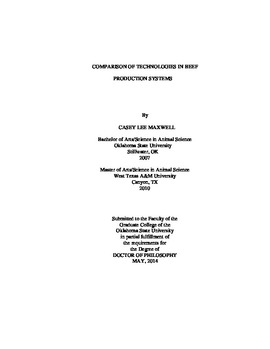| dc.contributor.advisor | Krehbiel, Clinton R. | |
| dc.contributor.author | Maxwell, Casey Lee | |
| dc.date.accessioned | 2015-06-17T20:06:54Z | |
| dc.date.available | 2015-06-17T20:06:54Z | |
| dc.date.issued | 2014-05 | |
| dc.identifier.uri | https://hdl.handle.net/11244/14992 | |
| dc.description.abstract | Beef steers (n = 180; initial BW = 250 � 19 kg) were randomized to one of two treatments in the pasture phase. Steers were implanted with 40 mg of TBA, 8 mg estradiol, and 29 mg tylosin tartrate (Conventional; CONV-Z) or received no implant (Natural; NAT). Conventional steers had improved ADG and a heavier final BW compared with NAT steers. Following the pasture phase, steers were assigned to a 2 x 2 factorial in the feedlot phase. Production system (NAT vs. CONV-Z) was maintained from the pasture phase, and the second factor was 7 vs. 12% roughage (DM basis; LOW vs. HIGH). Conventional steers ate more feed, gained faster and were more efficient compared with NAT steers. Hot carcass weight and LM area was increased for CONV-Z steers compared with NAT steers. Conventional steaks had increased slice shear values and Warner-Bratzler shear force compared with NAT steaks. Steaks from cattle fed CONV-Z had higher moisture content, lower lipid content, higher protein and higher ash content than steaks from NAT cattle. In experiment 2, steers (n = 336; initial BW = 379 � 8 kg) were randomized to similar treatments. CONV-Z steers gained faster and were more efficient than CONV steers, and CONV steers gained faster and were more efficient than NAT steers. Hot-carcass weight was increased for CONV-Z steers compared to CONV steers and compared to NAT steers. In experiment 3, beef steers (n = 54; initial BW = 391 � 3 kg) were randomized to one of two treatments, an all-natural treatment (NAT), and a conventional treatment (CONV-Z). Gain and feed efficiency was improved for CONV-Z steers compared to NAT steers. Daily water intake was numerically greater for NAT steers compared to CONV-Z steers and total feed and water efficiency was improved by 50% for CONV-Z steers compared to NAT steers. Natural steers spent more time at the feed and water bunk than CONV-Z steers. Hot-carcass weight and LM area were increased for CONV-Z compared to NAT steers. Data from these experiments show that conventional production increases animal performance and net return without drastically affecting meat quality. | |
| dc.format | application/pdf | |
| dc.language | en_US | |
| dc.rights | Copyright is held by the author who has granted the Oklahoma State University Library the non-exclusive right to share this material in its institutional repository. Contact Digital Library Services at lib-dls@okstate.edu or 405-744-9161 for the permission policy on the use, reproduction or distribution of this material. | |
| dc.title | Comparisons of technologies in beef production systems | |
| dc.contributor.committeeMember | Richards, Christopher J. | |
| dc.contributor.committeeMember | VanOverbeke, Deborah L. | |
| dc.contributor.committeeMember | Devuyst, Eric A. | |
| dc.contributor.committeeMember | Step, D. L. | |
| osu.filename | Maxwell_okstate_0664D_13229.pdf | |
| osu.accesstype | Open Access | |
| dc.type.genre | Dissertation | |
| dc.type.material | Text | |
| dc.subject.keywords | beef | |
| dc.subject.keywords | conventional | |
| dc.subject.keywords | feedlot | |
| dc.subject.keywords | natural | |
| thesis.degree.discipline | Animal Science | |
| thesis.degree.grantor | Oklahoma State University | |
